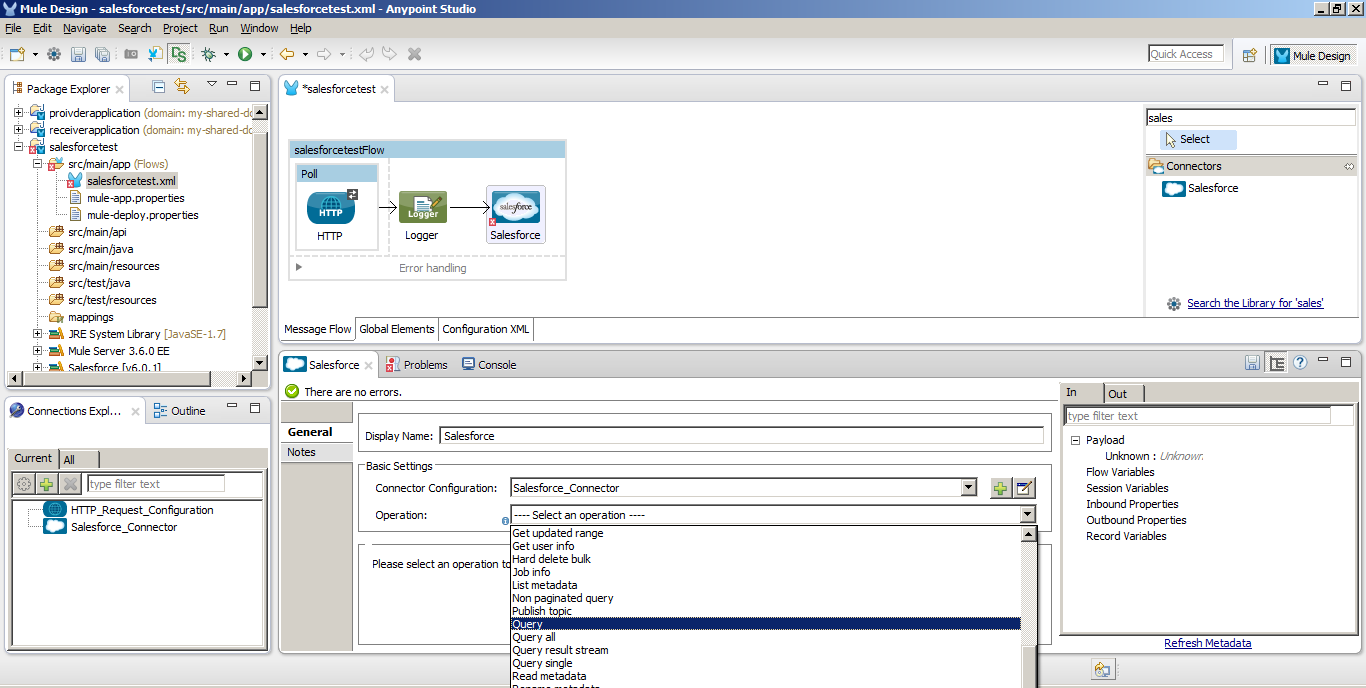I wanna consume a REST service exposed by Salesforce, right now I'm using a Sandbox instance and using Anypoint Studio to create my flow, I would like to know what's the best practice to implement it. Now I'm not sure about the salesforce connector allows me to consume the service, so, I'm using this components:

This is whole flow.
<mule xmlns:sfdc="http://www.mulesoft.org/schema/mule/sfdc" xmlns:file="http://www.mulesoft.org/schema/mule/file" xmlns:json="http://www.mulesoft.org/schema/mule/json" xmlns:vm="http://www.mulesoft.org/schema/mule/vm" xmlns:oauth2="http://www.mulesoft.org/schema/mule/oauth2" xmlns:http="http://www.mulesoft.org/schema/mule/http" xmlns="http://www.mulesoft.org/schema/mule/core" xmlns:doc="http://www.mulesoft.org/schema/mule/documentation"
xmlns:spring="http://www.springframework.org/schema/beans" version="CE-3.6.1"
xmlns:xsi="http://www.w3.org/2001/XMLSchema-instance"
xsi:schemaLocation="http://www.springframework.org/schema/beans http://www.springframework.org/schema/beans/spring-beans-current.xsd
http://www.mulesoft.org/schema/mule/core http://www.mulesoft.org/schema/mule/core/current/mule.xsd
http://www.mulesoft.org/schema/mule/http http://www.mulesoft.org/schema/mule/http/current/mule-http.xsd
http://www.mulesoft.org/schema/mule/vm http://www.mulesoft.org/schema/mule/vm/current/mule-vm.xsd
http://www.mulesoft.org/schema/mule/json http://www.mulesoft.org/schema/mule/json/current/mule-json.xsd
http://www.mulesoft.org/schema/mule/file http://www.mulesoft.org/schema/mule/file/current/mule-file.xsd
http://www.mulesoft.org/schema/mule/sfdc http://www.mulesoft.org/schema/mule/sfdc/current/mule-sfdc.xsd">
<http:request-config name="HTTP_Request_Configuration" host="https://test.salesforce.com" port="80" doc:name="HTTP Request Configuration" protocol="HTTPS">
<oauth2:client-credentials-grant-type clientId="3xQYwWqsvZUYbwMRLHiXQy9A23XXXtxg1OMxdXh5p4eoev53q26CmN0Yx0EyLf_HTLW9X" clientSecret="710XXX1723685311">
<oauth2:token-request tokenUrl="https://test.salesforce.com/services/oauth2/token"/>
</oauth2:client-credentials-grant-type>
</http:request-config>
<file:connector name="File" writeToDirectory="/Users/emoran/Desktop" autoDelete="true" streaming="true" validateConnections="true" doc:name="File"/>
<flow name="outbrain_3wintegrationFlow1">
<poll doc:name="Poll">
<fixed-frequency-scheduler frequency="10" timeUnit="SECONDS"/>
<http:request config-ref="HTTP_Request_Configuration" path="services/apexrest/outbrain_integration_messages/" method="GET" requestStreamingMode="ALWAYS" sendBodyMode="ALWAYS" doc:name="Consume SFDC LOG Service" doc:description="prueba" parseResponse="false" source="#[message.payload]" target="#[message.payload]">
<http:request-builder>
</http:request-builder>
<http:success-status-code-validator values="0..599"/>
</http:request>
</poll>
<logger message=">>>> RESPONSE FROM SERVER: #[message.payload]" level="DEBUG" doc:name="Logger"/>
<echo-component doc:name="Echo"/>
<file:outbound-endpoint path="/" outputPattern="refacciones.json" connector-ref="File" responseTimeout="10000" doc:name="File"/>
</flow>
</mule>
What would be the best approach to solve this?
Thanks

 (it is recommended to use a property placeholder to read them from property files so that you externalize these)
4) Create the flow (based on yours), remove the echo and file component. Add the Salesforce Endpoint. To query salesforce for accounts, select the salesforce endpoint in the flow, open the 'Mule propeties view' and select the Query in the drop down.
Refer to image img2_Salesforce_Query.png.
(it is recommended to use a property placeholder to read them from property files so that you externalize these)
4) Create the flow (based on yours), remove the echo and file component. Add the Salesforce Endpoint. To query salesforce for accounts, select the salesforce endpoint in the flow, open the 'Mule propeties view' and select the Query in the drop down.
Refer to image img2_Salesforce_Query.png.
 5) To query Salesforce accounts, place your SOQL in Salesforce endoint.
Refer to image img3_getAccounts.png
5) To query Salesforce accounts, place your SOQL in Salesforce endoint.
Refer to image img3_getAccounts.png
 6) You are nearly there - Add a logger component and print the payload #[payload].
You can add data mapper and a database insert Salesforce output to DB directly :D
Refer to image img4_datamapper_db.png
6) You are nearly there - Add a logger component and print the payload #[payload].
You can add data mapper and a database insert Salesforce output to DB directly :D
Refer to image img4_datamapper_db.png
 You are done!
You are done!